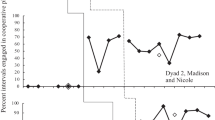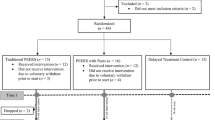Abstract
This study evaluated the use of the cool versus not cool procedure to teach sixteen children diagnosed with autism spectrum disorder how to initiate or respond to bids for joint attention and how to increase peer to peer communication with their peers. The cool versus not cool procedure consisted of the teacher modeling the targeted social behaviors both the cool (i.e., appropriate) and not cool (i.e., inappropriate) way, having the participants discriminate if the model was cool or not cool, having the participants state reasons why the model was cool or not cool, and having the participants role-play the targeted social behavior. All instruction was provided in a group format. Using a non-concurrent multiple baseline design across skills and participants the results showed that the cool versus not cool procedure was successful, with the majority of participants acquiring the two social behaviors and maintaining these behaviors after intervention had concluded.





Similar content being viewed by others
References
American Psychiatric Association. (2013). Diagnostic and statistical manual of mental disorders (5th ed.). Arlington: American Psychiatric Publishing.
Au, A., Mountjoy, T., Leaf, J. B., Leaf, R., Taubman, M., McEachin, J., & Tsuji, K. (2016). Teaching social behaviour to individuals diagnosed with autism spectrum disorder using the cool versus not cool procedure in a small group instructional format. Journal of Intellectual and Developmental Disability, 41(2), 115–124.
Charman, T., Swettenham, J., Baron-Cohen, S., Cox, A., Baird, G., & Drew, A. (1997). Infants with autism: An investigation of empathy, pretend play, joint attention, and imitation. Developmental Psychology, 5, 781–789.
Cooper, J. O., Heron, T. E., & Heward, W. L. (2007). Applied behavior analysis (2nd ed.). Upper Saddle River: Pearson.
Horner, R. H., Carr, E. G., Halle, J., McGee, G., Odom, S., & Wolery, M. (2005). The use of single-subject research to identify evidence-based practice in special education. Exceptional Children, 71, 165–179.
Jones, E. A., & Carr, E. G. (2004). Joint attention in children with autism: Theory and intervention. Focus on Autism and Other Developmental Disabilities, 19(1), 13–26.
Jones, E. A., & Feely, K. M. (2009). Parent implemented joint attention intervention for preschoolers with autism. Best of JSLP-ABA, 4, 74–89.
Laugeson, E. A., Frankel, F., Mogil, C., & Dillon, A. R. (2009). Parent-assisted social skills training to improve friendships in teens with autism spectrum disorders. Journal of Autism and Developmental Disorders, 39, 596–606.
Leaf, J. B., Tsuji, K. H., Griggs, B., Edwards, A., Taubman, M., McEachin, J., Leaf, R., & Oppenheim-Leaf, M. L. (2012). Teaching social skills to children with autism using the cool versus not cool procedure. Education and Training in Autism and Developmental Disabilities, 47, 165–175.
Leaf, J. B., Taubman, M., Leaf, J., Dale, S., Tsuji, K., Kassardjian, A., Alcalay, A., Milne, C., Mitchell, E., Townley-Cochran, D., Leaf, R., & McEachin, J. (2015a). Teaching social interaction skills using cool versus not cool. Child & Family Behavior Therapy, 37, 321–334.
Leaf, J. B., Townley-Cochran, D., Taubman, M., Cihon, J. H., Oppenheim-Leaf, M. L., Kassardjian, A., et al. (2015b). The teaching interaction procedure and behavioral skills training for individuals diagnosed with autism spectrum disorder: A review and commentary. Review Journal of Autism and Developmental Disorders, 2(4), 402–413.
Leaf, J. B., Leaf, J. A., Milne, C., Taubman, M., Oppenheim-Leaf, M., Torres, N., Townley-Cochran, D., Leaf, R., McEachin, J., & Yoder, P. (2016a). An evaluation of a behaviorally based social skills group for individuals diagnosed with autism spectrum disorder. Journal of Autism and Developmental Disorders.
Leaf, J. A., Leaf, J. B., Milne, C., Townley-Cochran, D., Oppenheim-Leaf, M. L., Cihon, J. H., et al. (2016b). The effects of the cool versus not cool procedure to teach social game play to individuals diagnosed with autism spectrum disorder. Behavior Analysis in Practice, 9(1), 34–49.
Leaf, J. B., Taubman, M., Milne, C., Dale, S., Leaf, J., Townley-Cochran, D., et al. (2016c). Teaching social communication skills using a cool versus not cool procedure plus role-playing and a social skills taxonomy. Education and Treatment of Children, 39(1), 44–63.
Macdonald, R., Anderson, J., Dube, W., Geckeler, A., Green, G., Holcomb, W., Mansfield, R., & Sanchez, J. (2006). Behavioral assessment of joint attention: A methodological report. Research in Developmental Disabilities, 27(2), 138–150.
Mundy, P., Sigman, M., & Kasari, C. (1994). Joint attention, developmental level, and symptom presentation in autism. Development and Psychopathology, 6(3), 389–401.
Pollard, J. S., Betz, A. M., & Higbee, T. S. (2012). Script fading to promote unscripted bids for joint attention in children with autism. Journal of Applied Behavior Analysis, 45, 387–393.
Sarokoff, R. A., & Sturmey, P. (2004). The effects of behavioral skills training on staff implementation of discrete-trial teaching. Journal of Applied Behavior Analysis, 37, 535–538.
Sarokoff, R. A., Taylor, B. A., & Poulson, C. L. (2001). Teaching children with autism to engage in conversational exchanges: Script fading with embedded textual stimuli. Journal of Applied Behavior Analysis, 34, 81–84.
Taubman, M. T., Leaf, R. B., McEachin, J., & Driscoll, M. (2011). Crafting connections: Contemporary applied behavior analysis for enriching the social lives of persons with autism spectrum disorder. DRL Books.
Taylor, B. A., & Hoch, H. (2008). Teaching children with autism to respond to and initiate bids for joint attention. Journal of Applied Behavior Analysis, 41, 377–391.
Watson, P. J., & Workman, E. A. (1981). The non-current multiple baseline design across-individuals design: An extension of the traditional multiple baseline design. Journal of Behavior Therapy and Experimental Psychiatry, 12(3), 257–259.
White, P. J., O’Reilly, M., Streusand, W., Levine, A., Sigafoos, J., Lancioni, G., Fragale, C., Pierce, N., & Aguilar, J. (2011). Best practices for teaching joint attention: A systematic review of the intervention literature. Research in Autism Spectrum Disorders, 5(4), 1283–1295.
Wichnick, A. M., Vener, S. M., Pytrek, M., & Poulson, C. L. (2010). The effect of script-fading procedure on responses to peer initiations among young children with autism. Research in Autism Spectrum Disorders, 4, 290–299.
Acknowledgements
We wish to thank Eric Rudrud and Kim Schultze for their help on this project especially as it applies to the fulfillment of the master’s degree. We also wish to thank the families and the penguins (the children) who participated in this study.
Author information
Authors and Affiliations
Corresponding author
Ethics declarations
Funding
This investigation was conducted to meet, in part, the requirements for the MA degree in the Department of Community Psychology, Counseling and Family Therapy at St. Cloud State University. This study was partially funded from a grant that we received from the Organization for Autism Research.
Ethical Approval
All procedures performed in studies involving human participants were in accordance with ethical standards of the institutional research committee and with 1964 Helsinki decoration and its later amendments or comparable ethical standards.
Informed Consent
Informed consent was obtained from the parents of all individual participants included in the study.
Conflict of Interest
This study was partially funded by a grant received from the Organization for Autism Research. The grant was directly provided to the third, seventh, eighth, and ninth author. The tenth author received an honorarium for her involvement. The seventh, eight, and ninth authors have commercial products for the procedure used in this study and own an agency that provides behavioral intervention, which includes using the procedure described in this study.
Rights and permissions
About this article
Cite this article
Milne, C., Leaf, J.A., Leaf, J.B. et al. Teaching Joint Attention and Peer to Peer Communication Using the Cool Versus Not Cool Procedure in a Large Group Setting. J Dev Phys Disabil 29, 777–796 (2017). https://doi.org/10.1007/s10882-017-9556-y
Published:
Issue Date:
DOI: https://doi.org/10.1007/s10882-017-9556-y




